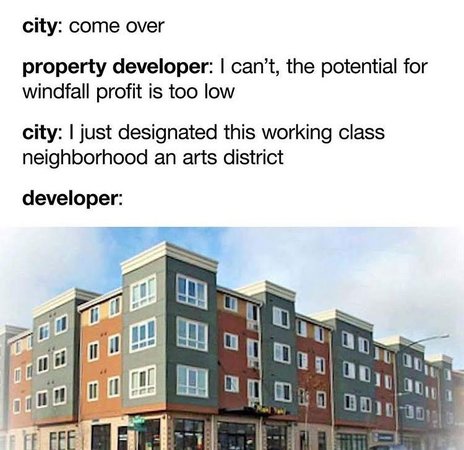Jillian Billard, for Artspace. Nov. 30, 2017.
Boyle Heights is a predominantly working class Hispanic neighborhood situated east of L.A.’s Arts District. Residents fear that the influx of gallery spaces in their neighborhood will lead to their displacement and ultimate cultural erasure. Members of the Boyle Heights Alliance Against Artwashing and Displacement (BHAAAD) are demanding that art galleries in Boyle Heights relocate to other, more affluent areas of the city.
Maga Miranda, a protestor affiliated with BHAAAD, told L.A. Weekly that “we’re not against art or culture… the Eastside has been an incredibly active place when it comes to art and culture. But the art galleries are part of a broader effort by planners and politicians and developers who want to artwash gentrification.”
If Boyle Heights needed any proof of the link between developing arts communities and gentrification of working class neighborhoods, they need look no further than New York City. NYC’s Chinatown has seen more than 60 galleries established in the past three years. The Chinatown Art Brigade writes that “rents have risen to an all time high and low-income Chinatown tenants and small business owners are being pushed out. Hyper-development—in the form of luxury condos, hotels and galleries—is putting the lives and livelihoods of long-term residents at risk.” The group acknowledges that gentrification is the result of a number of factors, however “as evidenced in SoHo, Chelsea and, more recently, Bushwick, art galleries tend to be among the first businesses to gentrify working class or industrial districts.” They are forced to ask the question “what, if any, are the points of unity between artists, galleries and the local community?”
Has “arts district” become a fancy way of saying “displacement”?
When artists and galleries move into what is branded as a “newly established art community,” they generally don’t think of themselves as gentrifiers so much as they think of themselves as pioneers of a “new community,” (as opposed to new members of the pre-existing, already culturally-rich community). So it’s not just that these art galleries attract developers like ants to a picnic; it’s also that they often display a blatant disregard for the rich history of the community they are overtaking.
Analysis: I was attracted to this article because it argues that artists are the leaders of gentrification, which contradicts the article I saw in Bloomberg City Lab. Regardless, this idea is widespread which makes it important to consider. The author’s question about “arts district” and “displacement” being synonymous is one I also have. In all, I am interested in finding out more about how these “bad” galleries that fuel displacement get their funding. Who, specifically, decides what goes where and when?




